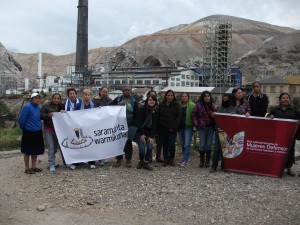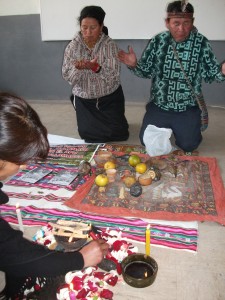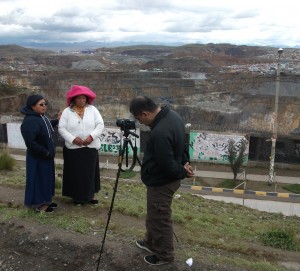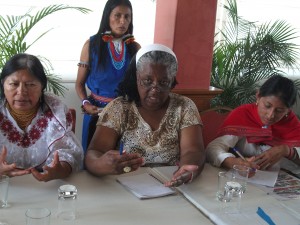I don’t have words to describe what I saw.

“ I don’t have words to describe what I saw, nor can I assimilate it. I felt sadness, anger and nausea.” Vidalina Morales from ADES (Associacion de Desarrollo Economico y Social) in El Salvador was debriefing on her experience visiting Oroya and Cerro de Pasco, towns in the highlands of Peru that have been profoundly impacted by mining. Other women from the delegation on resource extraction and climate change shared similar sentiments. We had just seen the ugliest, most unbridled and unregulated side of resource extraction.
 I am here in Peru for the Peoples’ Summit of the UN Climate Conference COP20 with a delegation of 27 women from across Latin America, including women from Ecuador, Colombia, Peru, Bolivia, Chile, El Salvador and Uruguay. The delegation is organized by Accion Ecologica, the Latin American Women’s Network of Defenders of Social and Ecological Rights, and the Saramantas Warmiuna, a women’s network in Ecuador. Before participating in the Peoples’ Summit , the delegation traveled to Oroya and Cerro de Pasco, to witness examples of mining devastation in Peru. A few years ago, I participated in a toxi-tour in Ecuador that visited areas devastated by unbridled petroleum extraction. This was a similar tour in Peru, but with a focus on mining.
I am here in Peru for the Peoples’ Summit of the UN Climate Conference COP20 with a delegation of 27 women from across Latin America, including women from Ecuador, Colombia, Peru, Bolivia, Chile, El Salvador and Uruguay. The delegation is organized by Accion Ecologica, the Latin American Women’s Network of Defenders of Social and Ecological Rights, and the Saramantas Warmiuna, a women’s network in Ecuador. Before participating in the Peoples’ Summit , the delegation traveled to Oroya and Cerro de Pasco, to witness examples of mining devastation in Peru. A few years ago, I participated in a toxi-tour in Ecuador that visited areas devastated by unbridled petroleum extraction. This was a similar tour in Peru, but with a focus on mining.
Our first stop was Oroya, which is about 3750 metres above sea level. According to a 2013 publication by the Blacksmith Institute on the World’s Top Ten Toxic Threats, Oroya is among the top ten most polluted towns in the world. There is a lead smelter in the middle of town and for over 100 years minerals from surrounding mines have been refined there. The smelter spews toxic waste into the water and air and there are essentially no environmental controls. “Emplomado” or “leadened” is an adjective that has become part of the vocabulary in Oroya. It describes someone whose body has been poisoned by lead. Lead poisoning affects the nervous system and causes symptoms similar to Parkinson’s disease.
 Even though mining has been part of Oroya’s history for over 100 years, there is strong resistance to it, including within the church. The Bishop of Oroya supports the community’s demands for more regulation. In 2005, the Diocese commissioned a study. Blood samples were taken from people in the area. The results showed that the levels of 13 toxins were significantly higher than allowable standards. “This study strengthened our advocacy,” explained Father Jaime Quisde Palomino, a local priest. The community took the case to the Supreme Court, and then to the Inter-American Human Rights Commission, where a verdict is pending. The community’s demands are modest: a decent pension program for workers, control and reduction of emissions, and recuperation and restoration of soil.
Even though mining has been part of Oroya’s history for over 100 years, there is strong resistance to it, including within the church. The Bishop of Oroya supports the community’s demands for more regulation. In 2005, the Diocese commissioned a study. Blood samples were taken from people in the area. The results showed that the levels of 13 toxins were significantly higher than allowable standards. “This study strengthened our advocacy,” explained Father Jaime Quisde Palomino, a local priest. The community took the case to the Supreme Court, and then to the Inter-American Human Rights Commission, where a verdict is pending. The community’s demands are modest: a decent pension program for workers, control and reduction of emissions, and recuperation and restoration of soil.
“Thank you for coming to Oroya,” said Father Jaime. “You have seen the results of 100 years of the extractive model of development and of its contamination.”
The next day we visited Cerro de Pasco. “This is another town with a world record,” our guide, Mario Palacio, remarked somewhat ironically. Cerro de Pasco, at 4380 metres above sea level, is the highest city in the world with more than 50,000 inhabitants. It is also one of the most contaminated. Again, we were faced with mining at its most extreme. Cerro de Pasco has had over 100 years of unregulated mining. Despite the fragile environment, there is an open pit mine in the middle of town which is slated for expansion. “Most towns have a town square or plaza. We have an open pit mine,” said Mario. The old part of the town is being bought up, abandoned and is literally falling into the pit as the mine expands. As part of the toxi-tour, we were taken to tailing ponds beside the town which are the colour of blood. We were taken to a “look- out” where we had a spectacular view of the mine, encircled by the town. Here, one by one, delegates gave testimonies of their experience of resource extraction in their community. We also recorded a video for the KAIROS advent mining justice campaign.
de-pasco.jpg”>
It was a profound experience, and the first part of the eight hour bus ride back to Lima was quiet and sombre. We had seen some of the most extreme impacts of the extractive model of development. But, as we made our way down the mountain, and after reflection and a shared meal, the energy picked up and the women passed around a microphone and began to sing. Some of the women sang secret songs in their native languages that are meant only for women and children. Others sang protest songs, romantic songs and tangos. These amazing women, who all face mining and petroleum extraction in their communities, are brought together by their courage and resilience, and by a need to defend their communities and Mother Earth. Some of them have tragic experiences of harassment, criminalization, displacement and the killing of family and community members. But on the bus back to Lima there was much laughter and song.
The following day we met to debrief and strategize. Women from El Salvador to Uruguay, from the Amazon, Andes and the coast, talked about the impact of extraction on their territories, their work in the communities, and strategies on how to work together. The testimonies were diverse, but what was remarkable were the similarities. I was also intrigued and encouraged by how many of the strategies echoed those I heard at KAIROS’ Gendered Impacts: Indigenous Women and Resource Extraction symposium on November 20 in Ottawa, just before leaving for South America. These included recommendations to support research and documentation at a community level; to make visible all the gendered impacts of resource extraction; to create legal and human rights instruments that will allow women to respond; to strengthen networks. There is resonance in this work throughout Latin America and in Canada. There is also a need to continue to support exchanges between Indigenous partners in the South, and between South and North.
